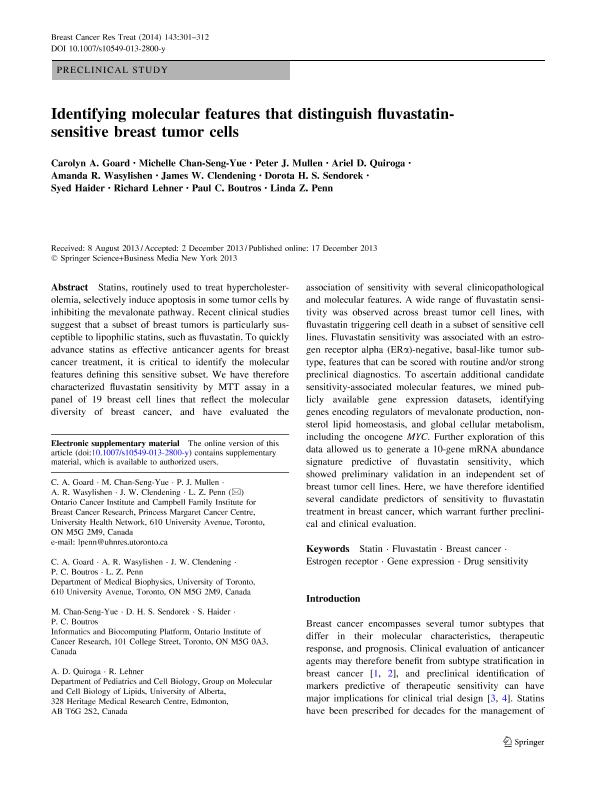Mostrar el registro sencillo del ítem
dc.contributor.author
Goard, Carolyn A.
dc.contributor.author
Chan Seng Yue, Michelle
dc.contributor.author
Mullen, Peter J.
dc.contributor.author
Quiroga, Ariel Dario

dc.contributor.author
Wasylishen, Amanda R.
dc.contributor.author
Clendening, James W.
dc.contributor.author
Sendorek, Dorota H. S.
dc.contributor.author
Haider, Syed
dc.contributor.author
Lehner, Richard
dc.contributor.author
Boutros, Paul C.
dc.contributor.author
Penn, Linda Z.
dc.date.available
2016-06-08T19:53:57Z
dc.date.issued
2014-01
dc.identifier.citation
Goard, Carolyn A.; Chan Seng Yue, Michelle ; Mullen, Peter J.; Quiroga, Ariel Dario; Wasylishen, Amanda R.; et al.; Identifying molecular features that distinguish fluvastatin-sensitive breast tumor cells; Springer; Breast Cancer Research And Treatment; 143; 2; 1-2014; 301-312
dc.identifier.issn
0167-6806
dc.identifier.uri
http://hdl.handle.net/11336/6118
dc.description.abstract
Statins, routinely used to treat hypercholesterolemia, selectively induce apoptosis in some tumor cells by inhibiting the mevalonate pathway. Recent clinical studies suggest that a subset of breast tumors is particularly susceptible to lipophilic statins, such as fluvastatin. To quickly advance statins as effective anticancer agents for breast cancer treatment, it is critical to identify the molecular features defining this sensitive subset. We have therefore characterized fluvastatin sensitivity by MTT assay in a panel of 19 breast cell lines that reflect the molecular diversity of breast cancer, and have evaluated the association of sensitivity with several clinicopathological and molecular features. A wide range of fluvastatin sensitivity was observed across breast tumor cell lines, with fluvastatin triggering cell death in a subset of sensitive cell lines. Fluvastatin sensitivity was associated with an estrogen receptor alpha (ERa)-negative, basal-like tumor subtype, features that can be scored with routine and/or strong preclinical diagnostics. To ascertain additional candidate sensitivity-associated molecular features, we mined publicly available gene expression datasets, identifying genes encoding regulators of mevalonate production, nonsterol lipid homeostasis, and global cellular metabolism, including the oncogene MYC. Further exploration of this data allowed us to generate a 10-gene mRNA abundance signature predictive of fluvastatin sensitivity, which showed preliminary validation in an independent set of breast tumor cell lines. Here, we have therefore identified several candidate predictors of sensitivity to fluvastatin treatment in breast cancer, which warrant further preclinical and clinical evaluation.
dc.format
application/pdf
dc.language.iso
eng
dc.publisher
Springer

dc.rights
info:eu-repo/semantics/openAccess
dc.rights.uri
https://creativecommons.org/licenses/by-nc-sa/2.5/ar/
dc.subject
Statin
dc.subject
Fluvastatin
dc.subject
Breast Cancer
dc.subject
Estrogen Receptor
dc.subject
Gene Expression
dc.subject
Drug Sensitivity
dc.subject.classification
Bioquímica y Biología Molecular

dc.subject.classification
Medicina Básica

dc.subject.classification
CIENCIAS MÉDICAS Y DE LA SALUD

dc.title
Identifying molecular features that distinguish fluvastatin-sensitive breast tumor cells
dc.type
info:eu-repo/semantics/article
dc.type
info:ar-repo/semantics/artículo
dc.type
info:eu-repo/semantics/publishedVersion
dc.date.updated
2016-06-01T13:36:49Z
dc.journal.volume
143
dc.journal.number
2
dc.journal.pagination
301-312
dc.journal.pais
Alemania

dc.journal.ciudad
Berlin
dc.description.fil
Fil: Goard, Carolyn A.. University Health Network. Princess Margaret Cancer Centre. Ontario Cancer Institute and Campbell Family Institute for Breast Cancer Research; Canadá. University Of Toronto; Canadá
dc.description.fil
Fil: Chan Seng Yue, Michelle . University Health Network. Princess Margaret Cancer Centre. Ontario Cancer Institute and Campbell Family Institute for Breast Cancer Research; Canadá. Ontario Institute of Cancer Research. Informatics and Biocomputing Platform; Canadá
dc.description.fil
Fil: Mullen, Peter J.. University Health Network. Princess Margaret Cancer Centre. Ontario Cancer Institute and Campbell Family Institute for Breast Cancer Research; Canadá
dc.description.fil
Fil: Quiroga, Ariel Dario. Consejo Nacional de Investigaciones Científicas y Técnicas. Centro Científico Tecnológico Tandil. Centro de Investigaciones en Física e Ingeniería del Centro de la Provincia de Buenos Aires; Argentina. University of Alberta; Canadá
dc.description.fil
Fil: Wasylishen, Amanda R.. University Health Network. Princess Margaret Cancer Centre. Ontario Cancer Institute and Campbell Family Institute for Breast Cancer Research; Canadá. University Of Toronto; Canadá
dc.description.fil
Fil: Clendening, James W.. University Health Network. Princess Margaret Cancer Centre. Ontario Cancer Institute and Campbell Family Institute for Breast Cancer Research; Canadá. University Of Toronto; Canadá
dc.description.fil
Fil: Sendorek, Dorota H. S.. Ontario Institute of Cancer Research. Informatics and Biocomputing Platform; Canadá
dc.description.fil
Fil: Haider, Syed. Ontario Institute of Cancer Research. Informatics and Biocomputing Platform; Canadá
dc.description.fil
Fil: Lehner, Richard. University of Alberta; Canadá
dc.description.fil
Fil: Boutros, Paul C.. University Of Toronto; Canadá. Ontario Institute of Cancer Research. Informatics and Biocomputing Platform; Canadá
dc.description.fil
Fil: Penn, Linda Z.. University Health Network. Princess Margaret Cancer Centre. Ontario Cancer Institute and Campbell Family Institute for Breast Cancer Research; Canadá. University Of Toronto; Canadá
dc.journal.title
Breast Cancer Research And Treatment

dc.relation.alternativeid
info:eu-repo/semantics/altIdentifier/url/http://link.springer.com/article/10.1007%2Fs10549-013-2800-y
dc.relation.alternativeid
info:eu-repo/semantics/altIdentifier/doi/10.1007/s10549-013-2800-y
dc.relation.alternativeid
info:eu-repo/semantics/altIdentifier/doi/http://dx.doi.org/10.1007/s10549-013-2800-y
Archivos asociados
